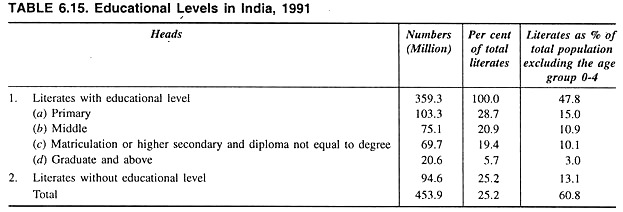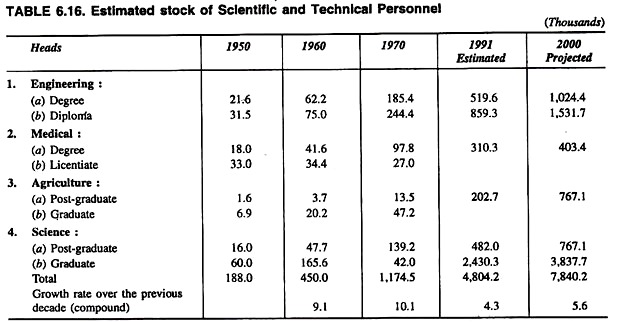In this article we will discuss about Human Capital Formation in India. After reading this article you will learn about: 1. Subject Matter of Human Capital in India 2. Stock of Human Capital in India.
Subject Matter of Human Capital in India:
India is possessing a huge size of human resources. In order to transform the liability of this huge size of population into assets adoption of various measures for human capital formation is very much essential.
The term human capital formation implies the development of abilities and skills among the population of the country. In order to develop various sectors of the economy, the country should introduce manpower planning for the development of its human resources.
Manpower planning indicates planning of human resources for meeting the development needs of the economy. Just for the proper utilisation of manpower resources the country should impart proper education to its population and train its labour force in technology, engineering, management, medicine and in many other fields connected with the development of various sectors of the economy.
ADVERTISEMENTS:
The most important factor in human capital formation is the development of top skills. As this skill formation is a time consuming process, the entire process of human resource development demands a long- term policy.
Stock of Human Capital in India:
Table 6.15 shows the stocks of human capital in India:
Table 6.15 reveals that considering the Indian population (excluding the age group 0-4), 60.8 per cent were literates in 1991. Out of this 47.8 per cent were literates with educational level and the remaining 13.1 per cent were literates without any educational level.
ADVERTISEMENTS:
Out of the people having educational level about 15 per cent had only primary education, 10.9 per cent had middle school education, 10.1 per cent had matriculation or higher secondary level and only 3.0 per cent had education up to graduate level. Table 6.16 again shows the growth of stock of scientific and technical personnel in India during the last three decades.
Table 6.16 reveals that India has become successful in training a number of scientific and technical manpower in the country during the last three decades. The total number of such manpower increased from 188 thousand in 1950 to 7,840.2 thousand in 2000.
Moreover, the growth rate of scientific manpower during the decade 1950-60 was to the extent of 9.1 per cent per annum and then the same rate increased to 10.1 per cent during the next decade 1960-70 in which there was huge expansion of basic and heavy industries in India. But during the next decade 1991-2000, the growth rate of scientific manpower declined to 5.6 per cent per annum.
ADVERTISEMENTS:
In respect of absolute numbers of scientific manpower India ranks fifth with its pools of 1.8 million. But if we take an appropriate index, i.e., the number of scientific personnel per 1000 population, then India stands third from the bottom level with a bare 2.63 scientific personnel per thousand of population.
Moreover, quality of scientific and technical personnel in India is not up to the mark and has been rated very low by the international stands. A large section of these personnel have no knowledge in applied sciences.
Thus for the proper utilisation of this technical manpower, these graduates and post-graduates should be given adequate knowledge on applied sciences.

